Drone guide: The right drone for windsurfing shots and important accessories
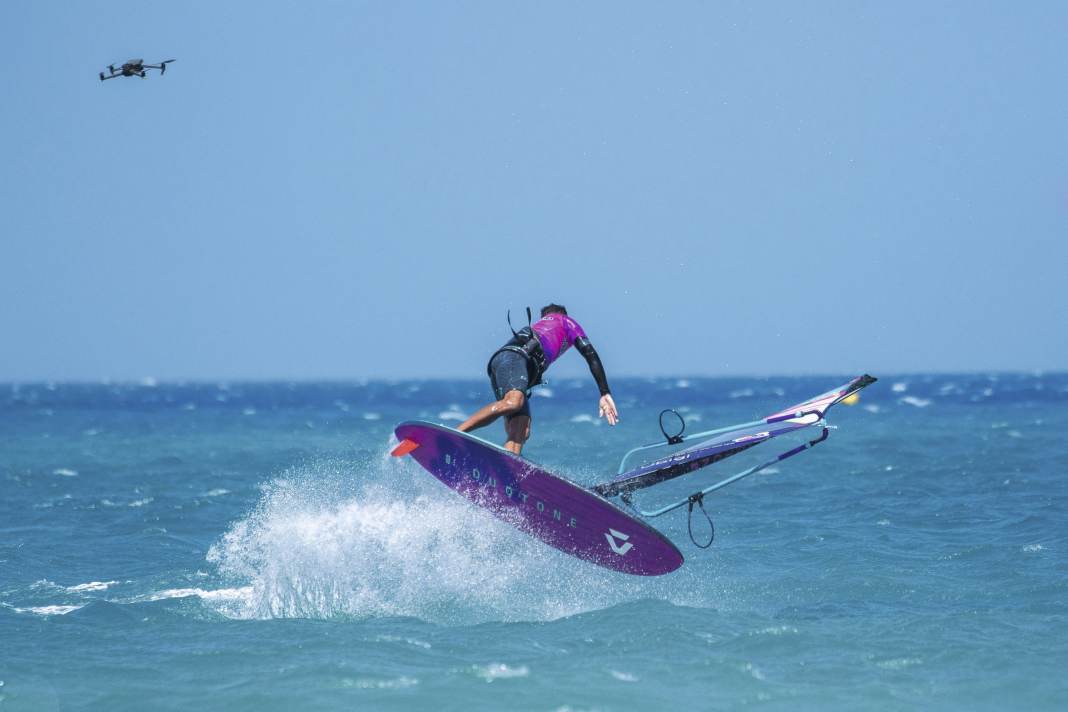





"If your photos aren't good enough, you weren't close enough" - the credo of (war) photographer Robert Capa (1913-1954) still applies in many situations today. You can get close with a long and expensive telephoto lens, with a water camera and a lot of swimming, with a boat - or with a drone. However, drones can be really annoying, especially the others. But then the problem is usually not the drone, but the remote control. Ten or twelve years ago, drone pioneers were often marvelled at in awe, but today not everyone is enthusiastic about the buzzing of drones on the beach. If you don't want to film exclusively in deserted areas, you should be able to put away the hysterical "privacy!" whining. But only those who observe the etiquette when flying will have lasting pleasure from the pictures and friends on the beach and will not further discredit the fantastic flying perspective: Respect, caution, good aeronautical control and knowledge of all the rules and dangers are therefore basic requirements before you flick the switch on the remote control to "take off".
Before buying a drone, you should determine exactly what technical features you need or expect. For windsurfing shots, for example, wind resistance, flight speed, camera quality and possibly also convenience when travelling all play a role.
Video goggles or classic remote control
A distinction is made between remote controllers with video glasses and those with a display. The display version includes controllers with an integrated display and controllers with an integrated holder for your mobile phone as a monitor. The mobile phone option is cheaper, but Drone professional Johannes Hertel recommends the controller with integrated display, as controlling it with a mobile phone is sometimes more difficult, and the integrated version is quicker to start.
The question remains: glasses or classic RC? The experts Johannes and Paul van Bellen are pretty much in agreement and both recommend the RC option. Paul van Bellen, for example, never flies with goggles, even in his most impressive videos, and remains loyal to classic RC, partly because flying with goggles is much more strenuous and a "spotter" is required to observe the drone. The super-fast FPV drones with video goggles are also the most suitable for very fast video cuts, as the horizon is completely at an angle in the image during most flight manoeuvres due to the lack of a 3-axis gimbal.
ND filters - useful or overrated?
Basically, ND filters ("neutral density") reduce the light falling on the camera sensor without changing the colour rendition of the image. Most attractively priced drones only have a fixed aperture, so an ND filter is the only option for creative control of the exposure time. Without a filter, the camera will inevitably set very short exposure times of 1/1000 of a second or less in bright light. This is good for razor-sharp action photos. However, an ND filter can be used in a targeted manner, for example to bring movement into an image with a longer exposure time, the "dragging" effect that blurs the water in the background when you fly at the same speed as the surfer. In videos, ND filters also ensure a natural-looking image. For smooth shots with a cinema effect, the shutter speed should be twice the frame rate (FPS).
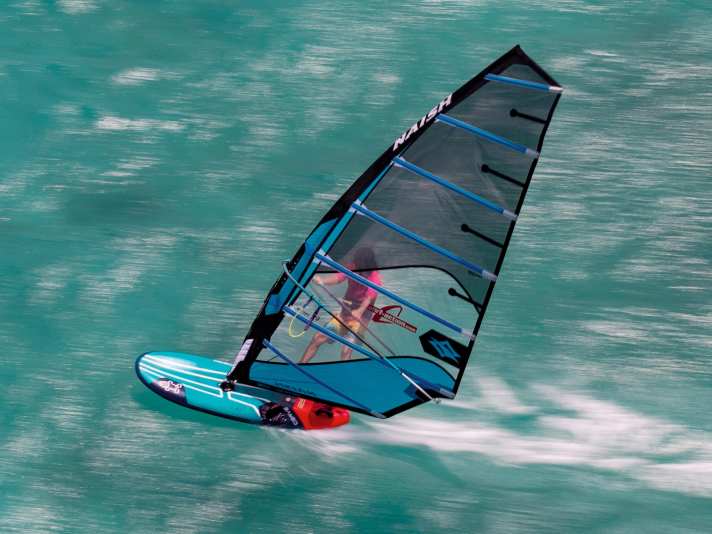
Without an adjustable aperture, an ND filter is the only option to achieve an exposure time of 1/60 second at 30 FPS. ND filters at levels 8, 16 and 32 are useful, allowing exposure times of less than 1/100 second to be achieved even in bright sunlight. Apps such as "Exposure" can be used to calculate the effects of different dark ND filters on the exposure time in advance, or you can simply try it out.
How ND filters work
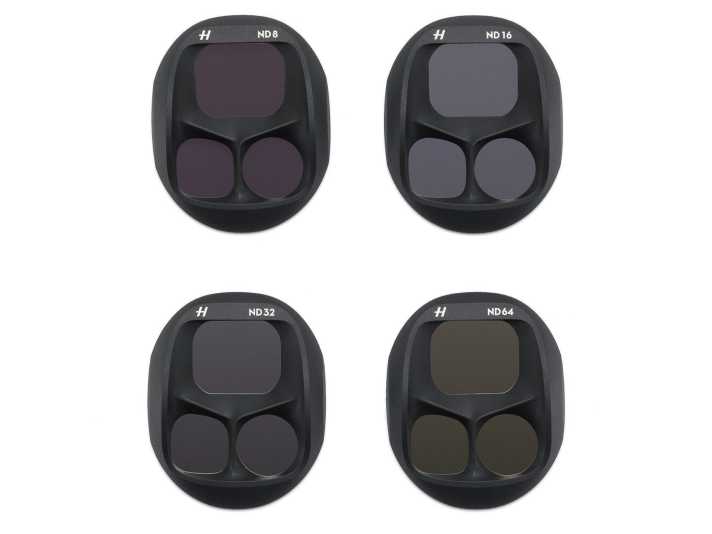
ND filters ("neutral density") in different strengths darken without distorting colours. In bright light, the exposure times can be extended for a natural look and adapted to the selected frame rate. For filming, 1/60th of a second is often exposed at 30 FPS (frames per second), 120th of a second at 60 FPS and so on.
Which drone class makes sense?
Mini drones in the <250 gram class are very compact and perfect for a trip in a van or aeroplane or even for a hike or bike tour. No drone licence is required in most countries and they already offer decent 4K video quality. The disadvantage, however, is the lower wind stability. According to Paul van Bellen, you can still take nice stable shots in winds of up to 15 knots, but above 20 knots the beach becomes not only mosquito-free but also drone-free.
In the surf test, a DJI Mini 3 Pro still performed well in freeride conditions with a 7.5 sail. However, once the testers had a head start in full glide, it was difficult to keep up. The video and image quality was fully convincing despite the smaller sensor. Johannes Hertel also summarises it well: "The Mini series is super good in terms of price/performance and how easy it is to take with you and use spontaneously. You can also use it for action, but you just have to be aware of the limits."
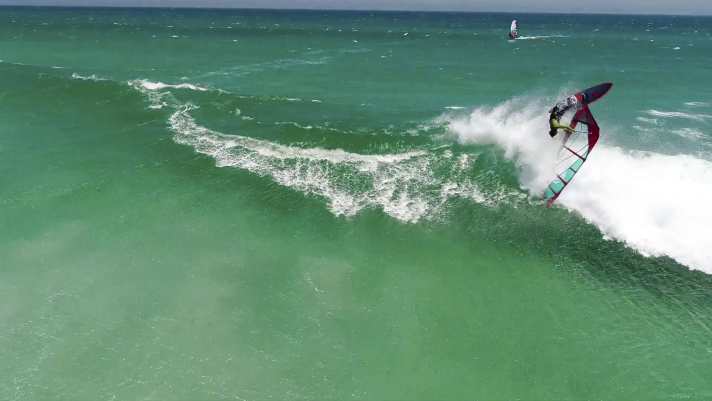
Drones in the upper league, which start at around 1000 euros, such as the DJI Air series (e.g. Air 3S), can be described as excellent all-rounders for sports use - with two cameras and significantly higher flight stability and plenty of reserves in strong winds. With more weight and more horsepower, these birds fly safely back into the nest even in 25 knots of offshore wind - even if you can get sweaty hands in winds with a 4.7 sail. In return, a licence and registration are required in most countries with a drip weight of more than 250 grams.
For the highest demands, only professional drones with up to 3 cameras, zoom and superior flight stability come into play. If you are looking for a more budget-friendly alternative, you can take a look at the drones from Potensic or other manufacturers, which are priced (in some cases significantly) below DJI. The Potensic Atom series in particular sounds interesting based on the printed data. It should weigh less than 250 g and offer good image quality, and according to the manufacturer, the Atoms should be able to fly at up to 5 Beaufort. However, we have not yet been able to test these drones to check whether they might be paper tigers after all.
Useful accessories: spare propeller and second battery
In addition to the drone itself, the right accessories also play an important role - spare propellers, additional batteries, controllers, ND filters. In most cases, the drone is supplied with a set of spare propellers. Johannes Hertel checks the propellers before every flight - something you also learn in the very useful online driving licence courses - for small tears or bends, because even this minor damage can quickly grow into a major problem, and propellers only cost a few euros.
You should buy at least one additional battery, because recharging at the spot usually takes too long, and manufacturers calculate flight times like car manufacturers calculate fuel consumption. The stated flight time is often over 40 minutes, but this will very quickly become less in stronger winds and sporty flying - just as a Porsche Panamera is unlikely to be content with nine litres if it is driven properly. One or two additional batteries in reserve not only ensure more flying pleasure, but also more usable photo and video material from a session. It is also extremely easy on the nerves if you can relax and make a short pit stop for a new battery with 30 per cent charge remaining instead of sucking the last electrons out of the only battery. After all, an empty "tank" is a much bigger problem with a drone over the North Sea than with a car on a country road.
Drone guide - from beginner to professional
Class war: An exemplary overview of the DJI range shows the decisive differences in cameras and flight performance - but also the overall weight.
Entry-level drone, under 300 euros
Example drone: DJI Mini 4K - sports drone with small sensor
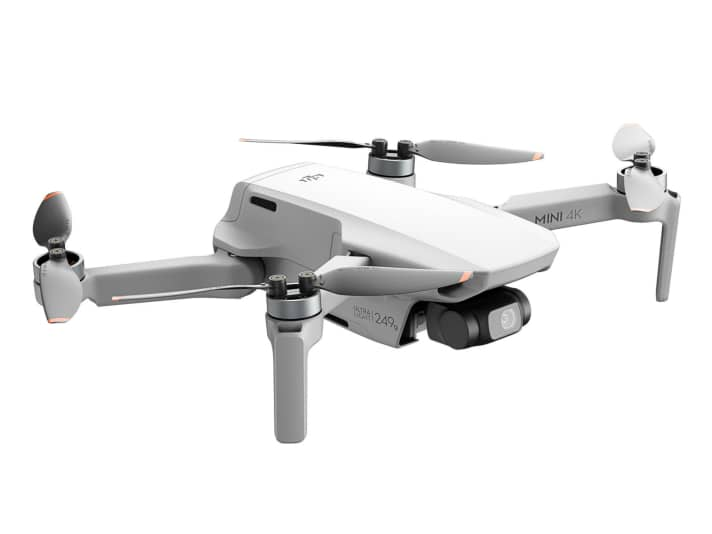
- Sensor size 1/2.3 inch
- under 250 g; no driving licence required
- Stable recordings in winds of up to 20 knots
- Top speed 16 m/s (57 km/h)
- Tracking, obstacle detection to the front only
- Price: 299 Euro
Fun class, under 500 euros
Example drone: DJI Flip - fun and sports drone with reduced performance
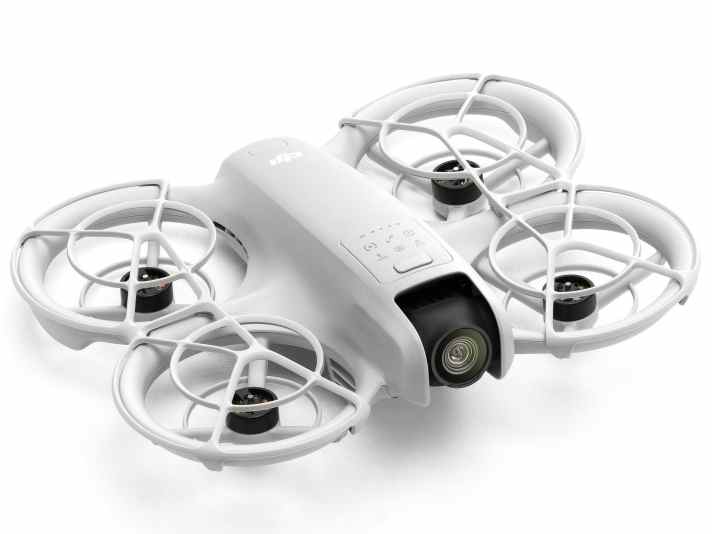
- Sensor size 1/1.3 inch
- under 250 g, no driving licence required
- Stable recordings in winds of up to 15 knots
- Top speed 12 m/s (43 km/h)
- Tracking, obstacle detection to the front only
- Integrated propeller guard
- Price: 439 Euro
Mid-range < 250 grams, under 1,000 euros
Example drone: DJI Mini 4 Pro - compact and perfect for travelling
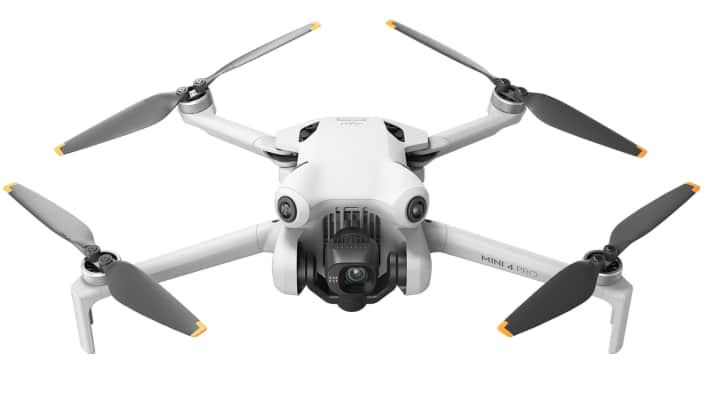
- Sensor size 1/1.3 inch
- under 250 g; no driving licence required
- Top speed 16 m/s (57 km/h)
- 4K video quality
- Stable recordings in winds of up to 20 knots
- Obstacle detection and all-round tracking (not in sport mode)
Price: 799 Euro
Oberliga > 250 grams, over 1,000 euros
Example drone: DJI Air 3S - all-rounder for sports use
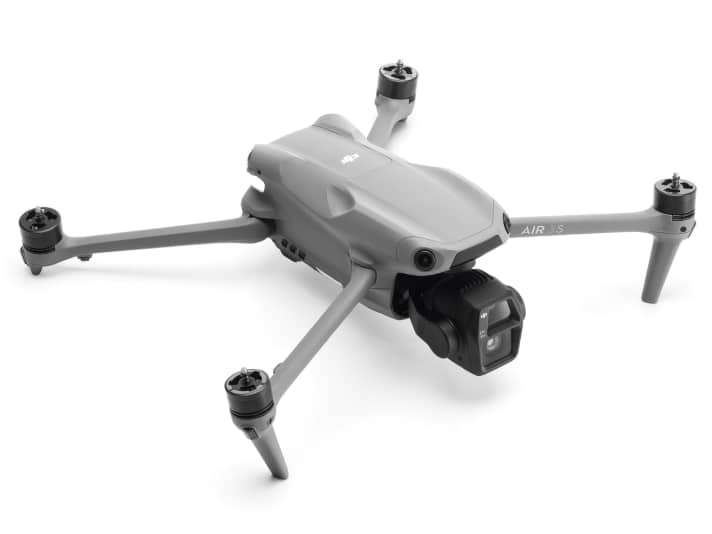
- Sensor size 1 inch
- over 250 g; driving licence required
- Top speed 21 m/s (75 km/h)
- Two cameras (wide-angle + telephoto)
- Stable recordings in winds of up to 25 knots
- Obstacle detection and all-round tracking (not in sport mode)
- Price: 1,099 Euro
Professional drone, no limits
Example drone: DJI Mavic 4 Pro - for high demands
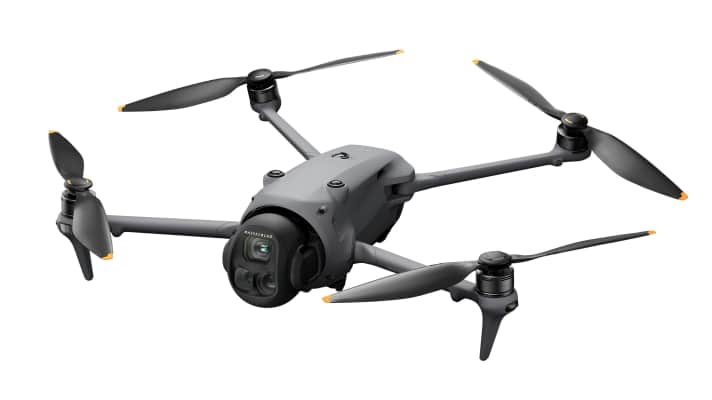
- Sensor size 4/3 inch
- Adjustable aperture on the main camera (f/2.0 to f/11)
- over 1000 grams; driving licence required
- 3 cameras (wide-angle, light telephoto, strong telephoto)
- Top speed 25 m/s (90 km/h)
- Stable recordings in winds of up to 35-40 knots
- Closed USB and SD ports against salt and rust
- Obstacle detection, lateral even at high speeds (up to 18 m/s)
- Price: 2,099 Euro
Drone glossary - the most important technical terms
Sensor size
This describes how large the light-sensitive part of the camera is that captures the image - like the camera's digital film. The larger the sensor, the better it can capture details and colours. Large sensors measure 1 inch diagonally, mid-range sensors often measure 1/1.3 inch and even smaller sensors measure 1/2 inch.
ISO
The ISO value indicates how sensitive the sensor is to light. A low ISO (for example ISO 100) means a lower sensitivity to light and therefore clearer, noise-free images - ideal in good lighting conditions.
Aperture
The aperture is an adjustable opening in the lens through which light falls onto the sensor - comparable to the pupil of the eye. The smaller the number, the larger the opening - meaning more light on the sensor. A larger aperture therefore helps in low light conditions. In contrast to digital cameras, most drones have a fixed (usually fast) aperture that cannot be adjusted.
ND filter
ND filters ("neutral density filters") could be described as "sunglasses" for the camera. If you only have a fixed aperture, but it is very bright, for example, you can use ND filters. This is the only way to achieve longer exposure times (important for filming, but also for taking photos).
Gimbal
A gimbal is a movable mount that stabilises the camera during flight. It automatically compensates for movements and vibrations of the drone so that the horizon remains level. With FPV drones, however, this is usually only in one axis.
FPS
Frames per second - stands for the number of individual images per second in a video. Similar to a flip-book. A higher FPS number, such as 60fps or 120fps, makes it possible to play back a recording later in the editing process without flickering in slow motion (1/2 0or 1/4). Classic values for a particularly smooth cinema look of calm scenes are 24fps or 30fps.
Focal length
The focal length describes how "close" or "far" a camera captures a subject. A smaller focal length results in a wider field of view. This is usually the main camera or the only camera on drones. With a wide angle, you have to fly pretty close to the action. Only mid-range drones and above have additional lenses that allow you to switch between different focal lengths. With a telephoto lens, it is often easier to follow a dynamic object because a few metres more or less distance to the object (almost unavoidable in the wave) has less effect on the size of the captured image.

